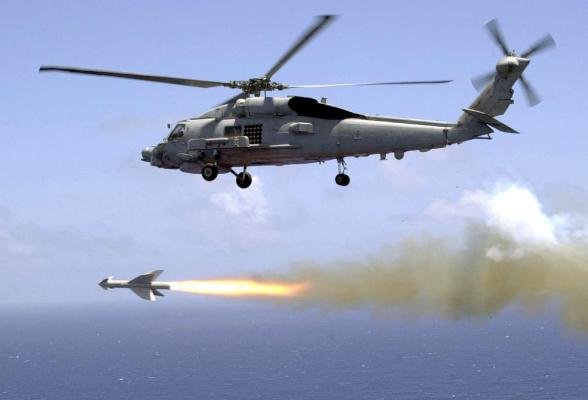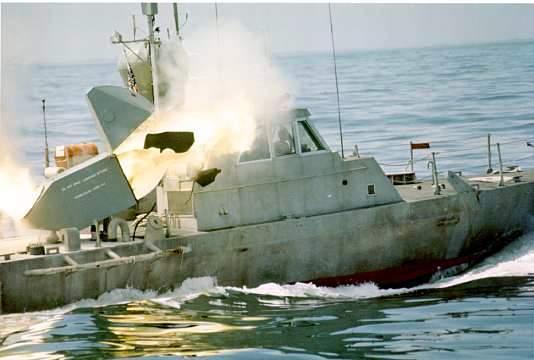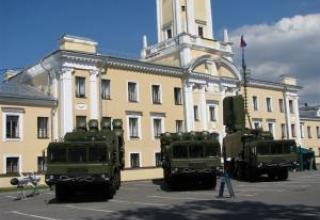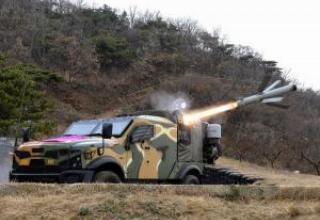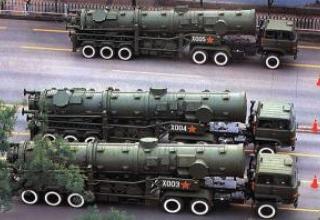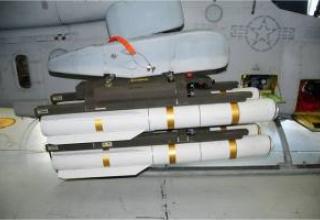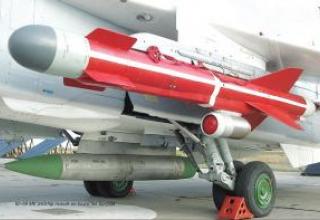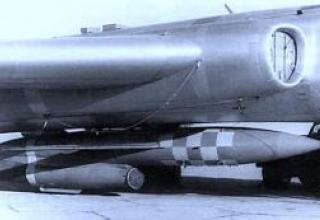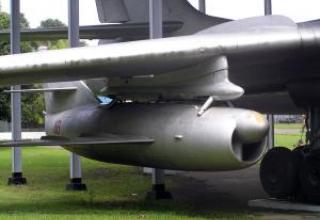In the early 1970s, the Norwegian firm Kongsberg Vapenfrabrikk (now Kongsberg Defence & Aerospace), with financial support from the U.S. Navy, developed a short-range anti-ship missile (SAR) Penguin ("Penguin"). The missile is equipped with an infrared homing head (HID), was designed specifically for operation in coastal skerries and was designed to provide reliable target selection against the background of heavily rugged coastline.
The basic version (later designated Mk1) came into service with the Royal Norwegian Navy in 1972 and was intended for use with missile boats and coastal batteries. Already in 1975 a modernized version of the missile with extended range - Mk2 was developed. Later modifications of Mk2 mod3 and Mk2 mod5 with improved CNS were adopted for service. The Penguin Mk1 and Mk2 modifications were armed with missile boats (see photo) from Norway, Greece, Turkey and Norwegian frigates like Oslo.
The Penguin family currently includes a number of modifications designed for use on a variety of carriers that are in service with the U.S. Navy, Norway, Sweden, Greece, Australia, Turkey, Brazil and several other countries. The latest in the Penguin family of missiles are the MkZ and Mk2 mod7 versions, which have improved combat efficiency, range and control systems on a modern element base.
The aviation version - Penguin MkZ (see photo), designed for armament of F-16 aircraft of the Norwegian Air Force, was adopted in 1987. The MkZ missile was also tested in the U.S., where it received the AGM-119A index, but was not put into service by the U.S. Air Force. The Mk2 mod7 modification is designed for use with helicopters and surface ships, and features a two-stage engine and folding wing. Under the designation AGM-119B it is used on SH-60B Seahawk helicopters of the U.S. Navy (see photo), as well as on S-70B helicopters of the Greek Navy. The delivery of AGM-119B missiles to the U.S. Navy began in 1994.
Composition:
The Penguin Mk2 mod7 (see the schematic) and MkZ (see the schematic) missiles have an aerodynamic "duck" pattern and a modular design. The following are located in the forward compartment: autonomous noise-immune infrared homing head, radio altimeter, autopilot and navigation control system servo drives. inertial navigation system platform in cardan suspension with one degree of freedom - on the roll, on-board computer and power supply. The central compartment accommodates the combat unit and the delayed contact fuse. In the tail compartment there is a single-chamber solid fuel engine and a safety executive mechanism. A cruciform wing with ailerons is mounted on the surface of the compartment.
The Mk2 missile of earlier modifications is equipped with the Mk19 (113 kg) Mk19 cumulative explosive reactive armament, used in the American Bullpup ASM-71 aircraft missile. The most advanced modification of the missile is the Mk2 mod7. The Mk2 mod7 is equipped with a new 120 kg WDU-39/B combat unit (according to some sources this BC was also used by Mk3 missiles). The Mk2 mod7 homing and control system is similar to the MkZ missile. The external features of the Mk2 mod7 from the Mk 3 are the shorter length and the wing of a larger scale that can be folded out at launch. The range of Penguin Mk3 is up to 50 km.
The combat application of Penguin missiles is based on the "shot for forget" principle. Depending on the target location, the missile can change its flight direction within ±180° according to a given program. After launch, the missile is reduced to a pre-selected and controlled altitude of the marching flight, during which the control is carried out using inertial navigation system. When the programmed range to the target is reached, the missile goes to a low or extremely low altitude. Then, after switching on the homing head to improve target search and capture, the flight altitude increases again (see trajectory diagram).
The control system allows the missile to operate outside of the target's line of sight, and can follow a complex pre-programmed trajectory, bend around obstacles on the ground and attack the target in the most vulnerable sectors (see diagram). The infrared homing head has high resolution, selectivity, and can be used to engage a wide range of targets under intense countermeasure conditions. It has a medium target range of approximately 1000 m and a 45° field of view.
Penguin missiles of various modifications are used in coastal anti-ship missile systems. The mobile battery of the Penguin can be installed on a tracked or wheelbase. In the first case, all components of the battery are placed on one tracked floating armoured vehicle - a control station including a command, control, reconnaissance and communication system, a fire control system (CLCS), a detection radar with a folding antenna, three container-type PU with ready to launch missiles and spare PKRs. The complex is served by three operators. The vehicle can move on the highway at 56 km / h and water at 5 km / h, deploy from camping to combat in 5 minutes. If the battery is installed on vehicles with a wheelbase, it includes a control section with LRS and radar with folding antenna and PU with six starting containers. When deployed in a combat position, the control station is placed on the coast in an area that provides radar detection and tracking of sea targets, and the IS are concealed in folds outside the line-of-sight of targets.
The ship complexes of Penguin Mk2 include: guided missiles, firing control and automatic missile check systems, transport and launch containers and launchers. Several versions of PU for ships of different classes have been developed. One of them is a rotary launcher with six Penguin missiles in transport and launch containers, there is a variant of twin rotary boosters with charging, feeding and storage devices (see diagram), as well as a lightweight, inoperable deck unit for small displacement ships (see photo). The performance of the missile system and the launch of the missile are monitored by a single operator from a console located in the ship's control post. The missiles are automatically checked before the launch from the same console.
Penguin Mk2 complex can receive target designation from any modern detection system. Information about the target is received by the ship's information post, where the tactical situation is assessed. The fire control system, taking into account the course and speed of the carrier ship and the target determines the coordinates of the aim point, which are entered into the missile control system, is launched.
Characteristics:
| Name | Mk1 | Mk3 (AGM-119A) |
Mk2 mod7 (AGM-119B) |
| Length, mm | 2950 | 3180 | 2960 |
| The diameter of the rocket body, mm | 280 | ||
| Wingspan, mm | 1420 | 1000 | 1420 |
| Start weight , kg | 330 | 370 | 365 |
| Range of fire, km | 20 | 50 | 30 |
| Flight speed maximum, m/sec. | 290 | ||
| Flying speed of the carrier | - | 0.7М | - |
| Launch height, m | - | 45-9000 | - |
| Permissible overload during manoeuvring, g | 10 | ||
Testing:
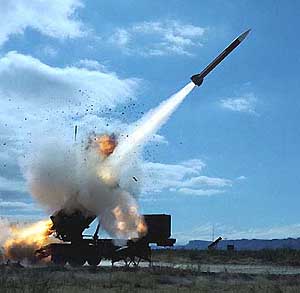
Since 1983, these air defense systems are in service with the U.S. ground forces, were supplied to America's NATO allies, as well as Israel, Saudi Arabia and Japan. The Patriot gained wide popularity during the Gulf War. And not even because it proved to be a reliable means of air defense, but because of skillfully organized advertising campaign. By the way, not a single enemy plane was shot down by them. But the volume of their sales after that war was about $3 billion, according to the manufacturer.
During the war in the Persian Gulf area, Patriot SAMs were used to fight Iraqi tactical missiles Scud. Their use required a warning from a reconnaissance satellite about the launch of the missile and the trajectory of its flight. This data had to be received at least 90 seconds before the warhead appeared on the radar screen. Typically, the interception was performed at altitudes of 5-10 km at a distance of 7-15 km from the battery position. Moreover, the warhead was not always destroyed completely, but only changed its flight path. The target could also be hit by fragments from the destroyed warhead due to the proximity of its interception. In real combat conditions, the effectiveness of the complexes turned out to be twice lower than the results of range tests: the probability of hitting the target was from 0.4 (according to the Soviet General Staff estimates) to 0.6 (according to the Pentagon), against the range of 0.8 - 0.95. In addition, Patriot often killed Scud actually on the ground, at the target, only increasing the damage to the object of attack. This, of course, required a serious improvement of the complex, especially its software. In particular, in addition to the main RAS-1 warhead designed to engage conventional air targets, the RAS-2 warhead was designed specifically to engage tactical ballistic missiles.
The purpose of the Patriot upgrade was to adapt the SAM system to defend small areas against tactical ballistic missile strikes. The objective of this version of the SAM system was not only to ensure that the tactical ballistic missile deviated from the target point, but also to destroy it. To that end, the software was refined, which also made it possible to combine the activities of the 3 Hawk and Patriot SAM systems under common control of a single fire control point. In the course of modernization, the missile's combat unit was improved and a new fuse was installed, the mass of projectiles was increased from 2 to 45 years. These changes did not affect the effectiveness of the missile when shooting at aerodynamic targets and later became standard for all missiles to be upgraded.
The PAC-2 variant was tested at the White Sands test site in November 1987, when a modified Patriot missile was hit by another Patriot missile that simulated the Soviet SS-23 ballistic missile.
As part of the second stage of the RAS-2 modernization, in the early 1990s, the GEM (Guidance Enhanced Missile) program developed a missile with an improved targeting system, including an advanced radio detonator. This improved the combat capabilities of the Patriot SAM system for intercepting the TBR.
At the same time, the QRP (Quick Response Program) provided for modification of the AN/MPQ-53 radar software in order to improve its capabilities when intercepting TBR. According to Reitheon's specialists, this allowed to increase the area defended by Patriot's SAMs against the TBR by 4 times as compared to the RAC-1 option.
Raytheon offers another modernization of the Patriot complex by creating a new version of the missile, designated as RAS-2 direct hit (RAS-2 Hit-to-Kill). The proposal to perform this upgrade is made in order to give the early versions of the system in service a direct hit capability similar to that of the RAS-3 missile, as well as to increase their strike capability.
The upgrade involves the replacement of the passive COS of the existing PAF-2 missiles by the active Ku-band, the replacement of the fragmentation fragmentation warhead and the introduction of a special propulsion system. The missile's software will also undergo modernization. The new components will provide the missile with the ability to manoeuvre during the pointing phase of the target before collision with it, as well as to destroy attacking ballistic or cruise missiles, aircraft and UAVs. The choice of RAS-2 for these purposes is due to its longer range and altitude compared with RAS-3. The use of active CLO can make it possible to implement scenarios of over-the-horizon intercepts.
Together with RAF-3, the Hit-to-Kill rocket could ensure that Patriot systems are in service until 2028. The US Army's SLEP program will include upgrades of the RAF-2 and PAC-2GEM missile variants to the PAC-2GEM+ configuration. This option will include a high-explosive fragmentation warhead, an improved in-flight reprogrammable radio fuse and a surface acoustic oscillator to improve the effectiveness of cruise missile countermeasures.
Sources:
- Широкорад А.Б. "История авиационного вооружения", -Мн.: Харвест, 1999.-560с.
- Шунков В.Н. "Фрегаты и сторожевые корабли", -Мн.: Попурри, 2003.-640с.
- http://farm1.static.flickr.com
- http://en.wikipedia.org)

